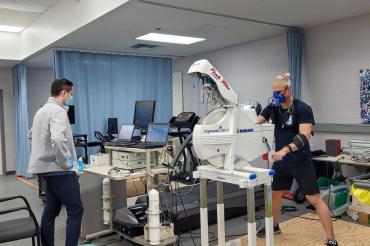Can restricting blood flow to athletes' limbs while training boost performance? U of T researchers investigate

Published: December 15, 2022
Ischemic preconditioning (IPC), a technique used to prepare an organ or tissue for a lack of blood or oxygen supply, was originally developed for use in clinical settings where there is an expected lack of blood and oxygen supply, for example during surgery or after an adverse event like a heart attack.
But could it be used to enhance athletic performance?
“IPC has been shown to have a protective effect on the body’s tissues to subsequent ischemic episodes – events where there is inadequate blood supply and, therefore, oxygen supply to a tissue or organ – that would typically cause cellular damage,” says Liam O’Brien, a first year PhD student at the University of Toronto Faculty of Kinesiology and Physical Education (KPE).
“So, when exercise researchers caught wind of it, they theorized it may be useful for enhancing exercise performance, seeing how our capacity to exercise is limited in part by the inability to deliver enough oxygen to the working muscles.”
The technique involves inflating blood pressure cuffs around one or multiple limbs at pressures that completely stop the flow of blood into or out of the limbs. The cuffs remain inflated for a brief period of about five minutes before being released for about five minutes, allowing for normal blood flow to resume through the limb. The process is repeated three to four times.
Researchers have speculated that if IPC improves the muscle’s ability to tolerate lack of oxygen supply, then perhaps this feature could be beneficial for prolonging exercise performance.
“Several studies have shown IPC to improve exercise performance, but there is little evidence as to why,” says O’Brien, who explored the question in his master’s thesis. “I wanted to fill in some of the gaps.”
While most of the studies had measured the effects of IPC on lower body exercises such as running or cycling, O’Brien was interested in investigating the effects of IPC on arm cycling exercise. He was also curious to see whether it might be useful for supramaximal intensity exercise – where the participants exercise as hard as they possibly can for the entirety of the test as opposed to pacing themselves.
“I theorized that if IPC works for upper body exercise, it may be useful for unique populations such as para-athletes or paddlers to help enhance their performance,” he says. “I was also interested in whether IPC was useful for supramaximal intensity exercise as most of the studies had investigated IPC during endurance exercises.”
O'Brien also wanted to investigate whether IPC works due to the placebo effect, a phenomenon whereby a treatment works due to the psychological expectations that it will work, as some researchers have speculated.
Working under the supervision of Professor Ira Jacobs, O’Brien recruited 18 athletic participants who completed three 45-second-long sprints using an arm cycle ergometer on separate visits to the lab. The first sprint served as a control trial, where the participants did not receive the IPC treatment, and instead lay passively for 30 minutes before exercise. During the other two visits, the participants completed their sprint after receiving either IPC (five minutes applied to both arms four times) or the placebo treatment. The placebo treatment consisted of the same protocol as the IPC trial, only at a low cuff pressure that did not interfere with their blood flow. The participants were told that the placebo treatment was also expected to enhance their performance through a similar mechanism to the high pressure treatment despite there being no actual benefit.
“We found that the average power outputs generated by the participants in our study were significantly higher after both the IPC and placebo treatments compared to the control trial,” says O’Brien. “However, the power outputs were not different between IPC and the placebo condition.”
While this result can be seen as an indication that IPC is in fact a placebo effect, O’Brien believes it is more likely that the changes in performance were due to the order that the participants completed the trials.
“Because the arm ergometer exercise was foreign to our participants, and the participants completed the control trial first, we believe that the second and third sprints were improved due to a learning effect rather than a performance enhancing effect of the IPC or placebo conditions,” he says. “This was supported through our statistical analyses as well as our lack of evidence of changes in the physiological variables such as oxygen consumption, heart rate, muscle blood flow or blood chemistry.”
While the study did not find clear evidence of a performance enhancing effect of IPC, these findings help to add information on the growing research area of ischemic preconditioning and exercise performance, says O’Brien.
“Research in this area has been active for over a decade, however much is still unknown about how IPC works in relation to exercise,” he says. “Our study is a small but important contribution toward building an improved understanding of the nuances of how IPC influences exercise performance.
“In the end, we hope to help illuminate the effects that this treatment has on exercise to help support athletes of all capabilities to achieve their full potential.”



